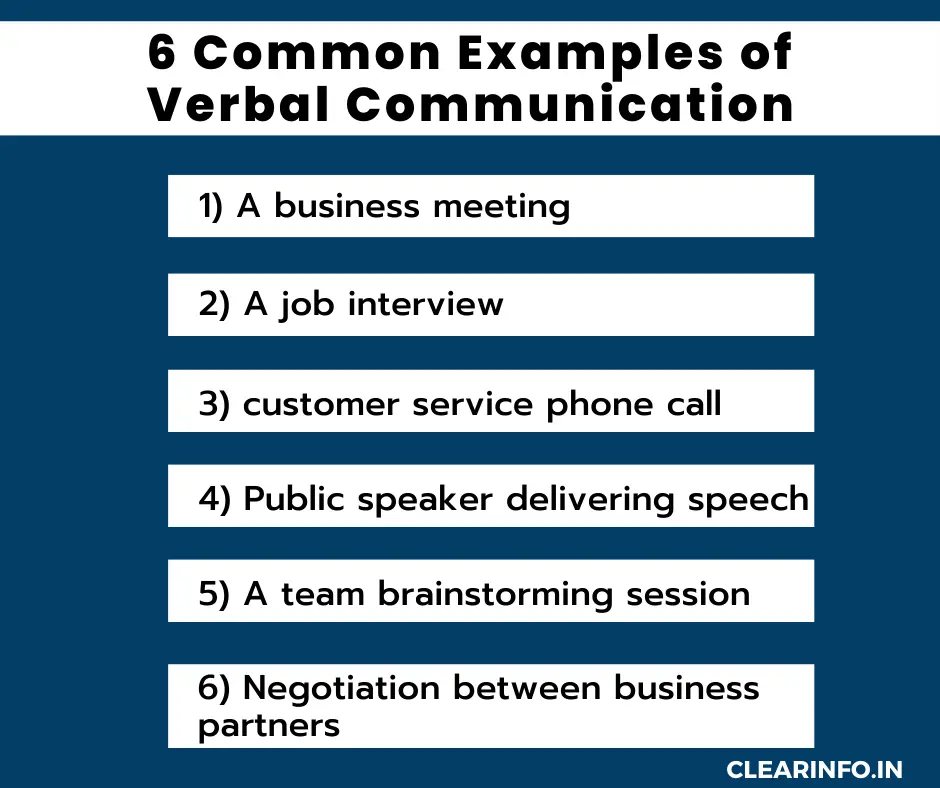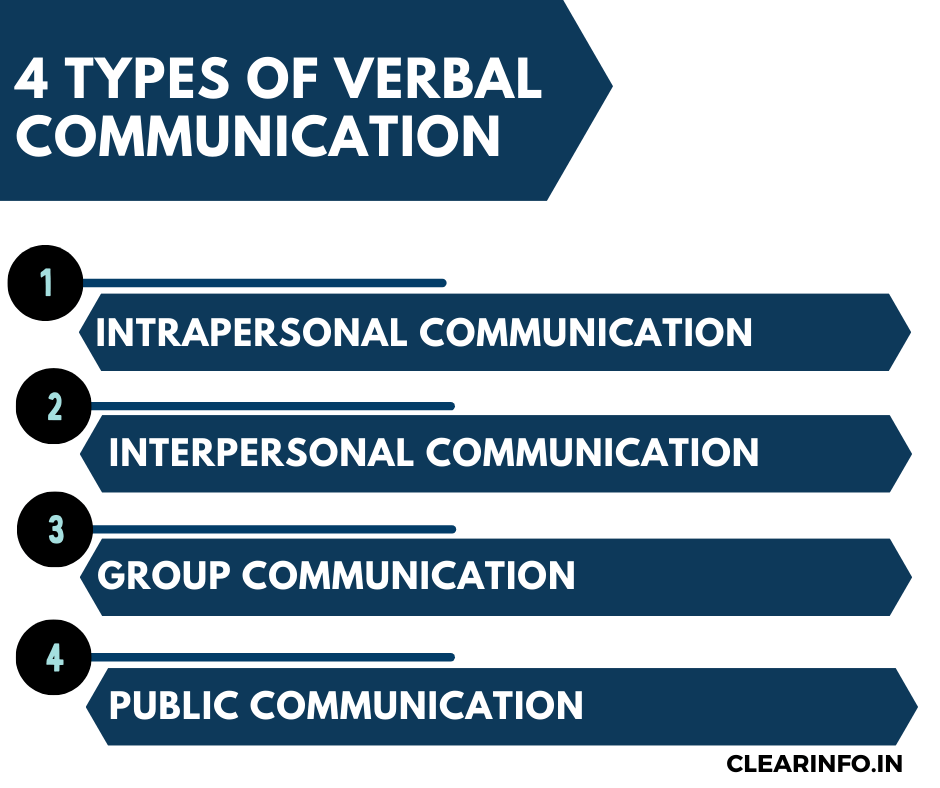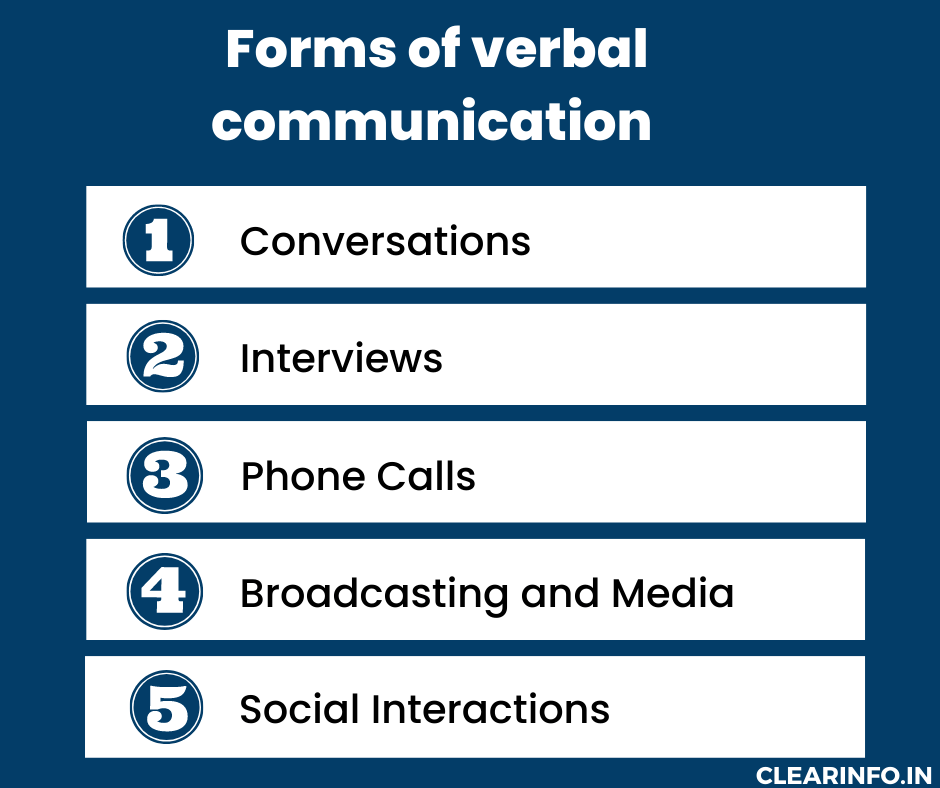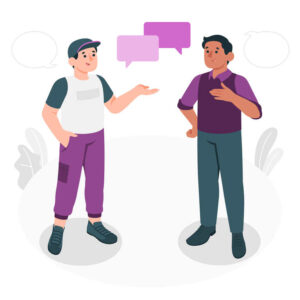Definition of verbal communication
“Verbal communication refers to the use of words in delivering the intended message. The main components of verbal communication are sound, words, speaking, and language.” – Albert Mehrabian
“Verbal communication is the process of exchanging information and ideas through the use of spoken words. It involves the use of language, tone, pitch, and other elements to convey meaning and intent.” – Richard L. Daft
What is verbal communication?
Verbal communication is the use of speech to convey messages between individuals or groups. It is an essential skill for effective communication in personal and professional settings. Verbal communication involves both speaking and listening, as it requires active participation from both the sender and the receiver of the message.
The sender is the person who initiates the communication by formulating their thoughts into words and delivering them through speech. The receiver, on the other hand, listens attentively to the spoken words and interprets their meaning.
Nature of verbal communication
Verbal communication is a type of communication that involves the use of spoken words or oral language. It is a dynamic process that includes both speaking and listening.
Verbal communication relies on various components such as words, vocabulary, tone, intonation, and non-verbal cues. It stands as a fundamental element of human interaction that plays a vital role in personal, professional, and social environments.
What are the characteristics of verbal communication?
Verbal communication is a vital part of human interaction, its diverse features play a crucial role in shaping effective and impactful interactions. The following are the main features of verbal communication:
1/ Interactive: Verbal communication is an interactive process that involves a sender and a receiver who engage in a dialogue or conversation.
2/ Multichannel: Verbal communication can involve multiple channels, including tone of voice, facial expressions, and body language, in addition to spoken words.
3/ Language-based: Verbal communication involves the use of language, whether it is spoken, written, or signed.
4/ Immediate: Verbal communication is often immediate and happens in real-time, allowing for instant feedback and clarification.
5/ Clarity and Fluency: Effective verbal communication emphasizes clear and consistent delivery of messages to ensure understanding.
Examples of verbal communication
In the list below, we have presented some real-life examples of verbal communication that showcase the various ways in which we use verbal words to convey messages and ideas.

1/ A business meeting where participants discuss project goals, challenges, and progress updates is a primary example of verbal communication in the workplace.
2/ A job interview is where a candidate answers questions and communicates their skills, experiences, and motivations to the interviewer.
3/ A customer service representative on a phone call, responding to a customer’s inquiry, resolving complaints, and providing solutions.
4/ A public speaker delivers a speech, inspiring and motivating the audience through the power of words and delivery.
5/ A team brainstorming session, where members collaborate and verbally express ideas, contributing to problem-solving and decision-making.
6/ A negotiation between two business partners, where they engage in verbal communication to discuss terms, reach agreements, and resolve conflicts.
Examples of verbal expression
- Giving encouragement by saying, “You can do it!” or “Keep up the good work!”
- Expressing agreement or approval by saying, “Yes, I completely agree with you.”
- Expressing disagreement or dissent by saying, “I respectfully disagree with that perspective.”
- Expressing admiration by saying, “You did an incredible job on this project.”
- When seeking clarification, one can employ the phrase, “Could you kindly provide a further explanation?”
- Expressing curiosity by asking questions such as, “How does that work?” or “What inspired you?
These examples demonstrate the diverse range of verbal expressions we use in our daily interactions to convey opinions, requests, and more.
Communication coaches Alexander Lyon and Mary Dapine have explored verbal and non-verbal cues in detail in the following video.
What are the 4 types of verbal communication?
The following types of verbal communication are essential to navigate different situations and contexts. Whether it is intrapersonal, interpersonal, group, or public communication, each type requires specific skills and approaches to communicate effectively. In this section, we will go deeper into the four primary types of verbal communication:

1/ Intrapersonal Communication: This refers to communication that occurs within an individual’s own mind. It involves self-talk, reflection, and internal dialogue. Intrapersonal communication helps in organizing thoughts, problem-solving, and making decisions.
2/ Interpersonal Communication: Interpersonal communication occurs when two or more individuals engage in communication with one another. It involves face-to-face conversations, discussions, and interactions where people exchange ideas, emotions, and information. Interpersonal communication is essential for building relationships, collaborating, and resolving conflicts.
3/ Group Communication: Group communication occurs when a small group of individuals, typically three or more, communicate with each other. This includes team meetings, brainstorming sessions, and group discussions. Group communication allows for collective decision-making, collaboration, and sharing of diverse perspectives.
4/ Public Communication: Public communication involves speaking to a large audience or public setting. It includes formal presentations, speeches, lectures, and public speaking engagements. Public communication requires effective delivery, clarity, and engaging speaking skills to convey information and persuade the audience.
Understanding these four types of verbal communication helps individuals navigate different communication contexts, adapt their approach, and effectively convey their message depending on the situation and audience.
Forms of verbal communication
Verbal communication includes various forms that facilitate the exchange of information, ideas, and messages. The below listed are just a few examples of the various forms that we encounter in our personal, professional, and social lives. Each form has its unique characteristics and purposes. Here are some common forms of verbal communication:

What are verbal communication skills?
Verbal communication skills involve the ability to effectively convey meaning through the use of language. This involves the use of words, tones, and nonverbal cues to express and interact with others.
Verbal communication skills include a range of abilities, such as pronunciation, grammar, vocabulary, and fluency, as well as the capacity to listen actively and respond appropriately to what is being said. Effective verbal communication also requires an awareness of the context and the audience, and the ability to adjust style and tone accordingly.
Why verbal communication skills are important
Verbal communication skills play a vital role in both personal relationships and professional interactions.
Strong verbal communication skills are crucial for collaboration and teamwork. They enable individuals to coordinate, exchange ideas, and provide constructive feedback. Effective communication within teams enhances productivity, promotes a sense of unity, and facilitates effective problem-solving.
Professionally, verbal communication skills are highly valued. Employers seek candidates who can clearly express their ideas, negotiate skillfully, and collaborate with colleagues. Therefore possessing strong verbal communication skills is essential for career growth and advancement.
Furthermore, verbal communication skills play a crucial role in establishing and maintaining relationships. By engaging in meaningful conversations and actively listening individuals can establish trust, foster mutual respect, and navigate conflicts more effectively
Additionally, verbal communication skills are necessary for success in public speaking, and leadership roles, where the ability to articulate ideas with confidence is critical.
How to improve verbal communication skills
Improving verbal communication skills involves a combination of verbal techniques and practices. Here are some effective strategies that can help:
1/ Active Listening: Actively listening to others is crucial for improving verbal communication skills. Practice being fully present in conversations, paying attention to both verbal and nonverbal cues.
2/ Expand Vocabulary: Enhance your vocabulary by reading and learning new words. This allows you to express yourself more precisely and effectively. Practice incorporating new words into your daily conversations.
3/ Practice Public Speaking: Public speaking exercises help build confidence and improve clarity in communication. Look for chances to address audiences, whether through presentations or by participating in a public speaking group.
4/ Seek Feedback: Actively seek feedback from trusted individuals to gain insights into your communication style. Ask for specific suggestions on areas to improve, such as clarity, organization, or tone.
5/ Role-play and Mock Conversations: Engage in role-playing scenarios or mock conversations to simulate real-life communication situations.
6/ Seek Professional Development: Consider attending workshops, courses, or training programs focused on communication skills.
7/ Clear Articulation: Work on improving your articulation and pronunciation. Practice speaking clearly and announcing words properly.
8/ Use Technology: With advances in technology, there are numerous tools available to improve verbal communication skills. For example, you can use video recording apps to record and review your presentations or speeches.
Important functions of verbal communication
Verbal communication serves several important functions that are vital for effective communication. One crucial function is information sharing, where individuals exchange knowledge, ideas, and facts, enabling the transfer of information.
Verbal communication can be used for persuasion and influence, whether in advertising, or marketing campaigns. It is also essential in problem-solving, as individuals engage in discussions and negotiations to resolve conflicts and find solutions.
Decision-making is another important function of verbal communication, where individuals exchange information and perspectives to arrive at informed choices. Lastly, verbal communication facilitates feedback, enabling individuals to receive constructive criticism, insights, and suggestions for improvement.
7 essential elements of verbal communication
Verbal communication, in particular, plays a crucial role in interpersonal interactions. By employing various elements, individuals can ensure their messages are clear, meaningful, and impactful. These elements form the foundation of verbal communication, including the sender, message, channel, receiver, feedback, context, and noise.
1/ Sender: The person who initiates the communication by encoding and transmitting the message.
2/ Message: The messages, concepts, or thoughts that the sender intends to express to the receiver.
3/ Channel: The medium or mode used to transmit the message, such as face-to-face conversation, phone call, email, or video call.
4/ Receiver: The person or audience who receives and decodes the message.
5/ Feedback: The receiver’s response or reaction to the message serves as feedback, offering the sender valuable insights into the message’s effectiveness.
6/ Context: The situational and environmental factors that influence communication, such as the setting, timing, and cultural background.
7/ Noise: Any external or internal factors that may interfere with the communication process, such as distractions, language barriers, or physical limitations.
By understanding and effectively managing these seven elements of verbal communication, individuals can enhance their communication skills and achieve better communication outcomes.
Related Reading: What are the basic elements of communication process
Why is verbal communication important in the workplace
Verbal communication holds significant importance in the workplace for several reasons. Firstly, it facilitates effective collaboration and teamwork among employees. Clear verbal communication allows individuals to share ideas, and provide feedback, leading to improved productivity. In fact, as per a report by McKinsey, well-connected team members experience a boost in productivity ranging from 20% to 25%.
Secondly, verbal communication helps in building strong working relationships. It allows for open and honest conversations, creating a positive work environment and mutual understanding.
Additionally, verbal communication plays a crucial role in delivering instructions and providing constructive feedback, which contributes to enhanced performance and professional growth. It can also help in career advancement, as it allows executives to showcase their skills, and present their accomplishments.
Verbal communication further supports effective customer service, as employees can engage in meaningful conversations with clients, and address their needs.
In the absence of effective verbal communication, misunderstandings, conflicts, and unproductive relationships may arise, leading to poor performance, low morale, and decreased outcomes.
Overall, verbal communication is vital in the workplace as it promotes effective collaboration, information sharing, problem-solving, and customer interaction, leading to overall success and productivity within the organization.
Difference between verbal and non-verbal communication
The below table highlights some of the key differences between verbal and nonverbal communication. Both forms of communication are important and complementary, and mastering both can enhance one’s overall communication effectiveness.
Verbal Communication | Non-Verbal Communication |
Involves spoken or written words | Doesn't involve words or language |
Involves the use of vocal tone, pitch, and volume | Relies on facial expressions, body language, gestures, and tone of voice |
Provides explicit and specific information | Conveys implicit messages and emotions |
Can be easily recorded or documented | Typically transient and difficult to document |
Can be easily misunderstood due to misinterpretation of words | Can be more universally understood across cultures |
Primarily conveys information, ideas, and thoughts | Conveys emotions, attitudes, and non-linguistic cues |
Can be mediated through various technologies (e.g., phone, email, video conferencing) | Generally requires physical presence for effective communication |
Can be formal or informal depending on the context | Can be subconscious and unintentional |
Examples include conversations, speeches, presentations, and written documents | Examples include body language, facial expressions, hand gestures, and eye contact |
By being aware of the key distinctions between verbal and nonverbal communication, we can enhance our overall communication skills, foster deeper connections, and achieve greater understanding in our interactions with others.
Benefits and limitations of verbal communication
Advantages of Verbal Communication:
- Enables real-time feedback and clarification, reducing misunderstandings.
- Facilitates the clear transmission of complex ideas and information.
- Offers opportunities for persuasive and compelling delivery through tone and vocal cues.
- Enhances relationship building and social interaction through active listening and response.
- Enables collaboration and teamwork through real-time coordination and negotiation of ideas.
Limitations of Verbal Communication:
- Can be affected by external factors such as noise, interruptions, or environmental conditions.
- Differences in communication skills among individuals may lead to misunderstandings or misinterpretations.
- Effectiveness relies heavily on the speaker’s ability to convey thoughts and convey emotions.
- Verbal information is subject to memory limitations and may be forgotten over time.
Related Reading: Verbal communication positives and negatives
Advantages of written communication over verbal communication in an organization
Written communication offers several advantages over verbal communication in an organization. Firstly, written communication provides a permanent record of information, ensuring clarity and accuracy in documentation. Secondly, written communication enables effective communication across time and distance.
This is particularly beneficial for organizations with remote teams or international offices. Additionally, written communication allows for careful planning and revision, providing the opportunity to craft well-thought-out messages and presentations.
Alternatives to verbal communication
1/ Written Communication: The written word is a powerful alternative to verbal communication. Written communication includes various mediums such as emails, letters, memos, reports, and text messages. Written communication allows for the careful crafting of messages, providing a permanent record and the opportunity for recipients to review and refer back to the information as needed.
2/ Visual Communication: Visuals, such as charts, graphs, infographics, and images, can effectively convey information and ideas. Visual communication is especially useful when presenting complex data or concepts.
Must Read: What are the importance and limitations of visual communication
3/ Nonverbal Communication: Nonverbal cues such as facial expressions, gestures, body language, and eye contact, can communicate messages without the need for spoken words.
4/ Digital Communication: With the rise of technology, electronic communication methods have become increasingly popular. This includes methods such as email, instant messaging, video conferencing, and social media platforms.
Must Read: Electronic communication advantages and disadvantages
Frequently Asked Questions
Q1) What is verbal communication and examples?
Ans: Verbal communication refers to the act of conveying information and messages through spoken language. It involves the use of words to express thoughts and engage in conversation. Examples of verbal communication include engaging in discussions, delivering speeches, participating in interviews, exchanging ideas in meetings, or even making phone calls to communicate with others.
Q2) What is verbal and non-verbal communication?
Ans: Verbal communication involves the use of spoken words, while non-verbal communication includes facial expressions, body language, gestures, and tone of voice.
Q3) What is verbal communication class 10
Ans: In class 10, verbal communication is typically taught to help students develop effective speaking and listening skills. It focuses on understanding the importance of clear communication and using appropriate language in various situations.
Q4) Where is verbal communication
Ans: Verbal communication takes place in diverse settings such as workplaces, educational institutions, social gatherings, and personal conversations. It is present in any situation where individuals engage in spoken or written exchanges to convey information, express thoughts, or establish connections with others.
Q5) What is verbal short answer?
Ans: A verbal short answer refers to a brief response provided using vocal language to a question or statement. It is a concise reply that conveys a message or information with clarity.
Q6) What is a verbal presentation?
Ans: A verbal presentation involves conveying information or ideas to an audience through oral words. It typically involves using visual aids, such as slides or charts, to support the presentation and engage listeners.
Q7) How to improve verbal communication
Ans: Individuals can improve their verbal communication skills by implementing various techniques, such as active listening, using clear and concise language, being mindful of body language and tone of voice, and following good communication principles.
Q8) What is the medium of message in verbal communication
Ans: The mediums used in verbal communication can vary, including face-to-face conversations, phone calls, recorded messages, emails, letters, or text messages. The choice of medium depends on the specific communication context and the preferences of the individuals involved in the exchange.



